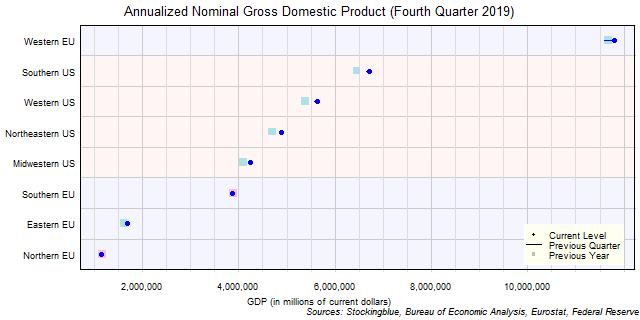
The chart above shows the annualized nominal gross domestic product (GDP) in each EU and US region as of the fourth quarter of 2019 in millions of dollars, the change from the previous quarter, and the GDP one year prior. The Western EU is the only EU region that has a larger GDP than any US region.
Findings
- The difference between the region with the largest GDP, the Western EU, and the region with the smallest, the Northern EU, is $10,651,690.98 million (up from $10,461,721.58 million last quarter and up from $10,515,388.73 million last year). The Western and Northern EU had the largest and smallest GDP respectively both last quarter and last year.
- The Western EU has 10.29 times the GDP that the Northern EU does. The ratio of largest GDP to smallest GDP went up from 10.17 last quarter and up from 10.04 last year.
- Eight regions (4 US, 4 EU) saw their GDP rise in current dollars from the previous quarter..
- Six regions (4 US, 2 EU) saw their GDP rise in current dollars from last year while two (0 US, 2 EU) saw it drop.
- All EU drops in GDP are attributed to currency rate fluctuations.
Caveats
- Data is from the fourth quarter of 2019, the third quarter of 2019, and the fourth quarter of 2018.
- The data is seasonally adjusted in current dollars.
- Euros are converted to dollars at an average exchange rate of 1.11 for the fourth quarter of 2019, 1.11 for the third quarter of 2019, and 1.14 for the fourth quarter of 2018 according to historic rates listed at the Federal Reserve (see source link below).
- US data comes in an annualized format which the EU does not, thus EU data is annualized by multiplying the quarterly figure by four.
- US growth rates may differ from those provided by the Bureau of Economic Analysis as the BEA's growth rates are based on chained dollars in conjunction with the chain index or the quality index for real GDP. The growth rates listed here are based on nominal GDP.
- All figures are rounded to the nearest hundredth.
- The Eastern EU consists of Poland, Czech Republic, Romania, Hungary, Slovakia, Bulgaria, Croatia, Slovenia, Lithuania, Latvia, and Estonia.
- The Midwestern US consists of Illinois, Ohio, Michigan, Indiana, Minnesota, Wisconsin, Missouri, Iowa, Kansas, Nebraska, North Dakota, and South Dakota.
- The Northeastern US consists of New York, Pennsylvania, New Jersey, Massachusetts, Maryland, Connecticut, New Hampshire, Delaware, Maine, Rhode Island, and Vermont.
- The Northern EU consists of Sweden, Denmark, and Finland.
- The Southern EU consists of Italy, Spain, Portugal, Greece, Cyprus, and Malta.
- The Southern US consists of Texas, Florida, Georgia, North Carolina, Virginia, Tennessee, Louisiana, South Carolina, Alabama, Kentucky, Oklahoma, Arkansas, Mississippi, and West Virginia.
- The Western EU consists of Germany, United Kingdom, France, Netherlands, Belgium, Austria, Ireland, and Luxembourg.
- The Western US consists of California, Washington, Colorado, Arizona, Oregon, Utah, Nevada, New Mexico, Hawaii, Idaho, Alaska, Montana, and Wyoming.
Details
In absolute terms, the Northern EU saw the smallest increase over the previous quarter with a gain of $6,426.90 million. The Western EU had the largest growth with a gain of $196,396.30 million. Year over year, the Southern EU had the largest decrease with a drop of $17,656.22 million while the Southern US had the greatest increase with a gain of $256,338.20 million.
In relative terms, the Southern EU had the smallest increase over the previous quarter with a 0.52% rise in GDP while the Eastern EU had the greatest increase with a 1.83% rise in GDP. Year over year, the Northern EU had the largest decrease with a 1.40% drop in GDP while the Western US had the largest growth with a 4.43% rise in GDP.
The Western EU accounted for nearly one-third of the economic output of the EU and US at 29.53%. It, combined with the Southern US accounted for nearly half of the economic output of the two superstates at 46.32%. Adding in the Western and Northeastern US accounts for nearly three-fourths of total economic output in the two Unions at 72.63%.
No region overcame another region in the quarter or over the course of the year. Although the Northern EU had the smallest economy overall, its component states had the second largest median GDP at $349,440.43 million. The Western EU which had the largest GDP overall, had the largest median GDP of component states at $724,213.51 million. These were followed by the Midwestern US (with a median GDP of $344,369.20 for its component states), the Northeastern US ($288,984.70), the Southern US ($258,504.95), the Southern EU ($222,446.44), the Western US ($180,406.20), and the Eastern EU ($68,506.98).
Sources
Eurostat. 2020. "GDP and Main Components." Accessed April 22, 2020. https://appsso.eurostat.ec.europa.eu/nui/show.do?query=BOOKMARK_DS-406779_QID_265259FB_UID_-3F171EB0&layout=TIME,C,X,0;GEO,L,Y,0;UNIT,L,Z,0;S_ADJ,L,Z,1;NA_ITEM,L,Z,2;INDICATORS,C,Z,3;&zSelection=DS-406779UNIT,CP_MEUR;DS-406779INDICATORS,OBS_FLAG;DS-406779S_ADJ,SCA;DS-406779NA_ITEM,B1GQ;&rankName1=UNIT_1_2_-1_2&rankName2=INDICATORS_1_2_-1_2&rankName3=NA-ITEM_1_2_-1_2&rankName4=S-ADJ_1_2_-1_2&rankName5=TIME_1_0_0_0&rankName6=GEO_1_2_0_1&sortC=ASC_-1_FIRST&rStp=&cStp=&rDCh=&cDCh=&rDM=true&cDM=true&footnes=false&empty=false&wai=false&time_mode=NONE&time_most_recent=false&lang=EN&cfo=%23%23%23%2C%23%23%23.%23%23%23.
Federal Reserve. 2020. "Foreign Exchange Rates." Accessed April 23, 2020. https://www.federalreserve.gov/releases/g5/.
US Bureau of Economic Analysis. 2020. "GDP by State." Accessed April 21, 2020. https://www.bea.gov/data/gdp/gdp-state.